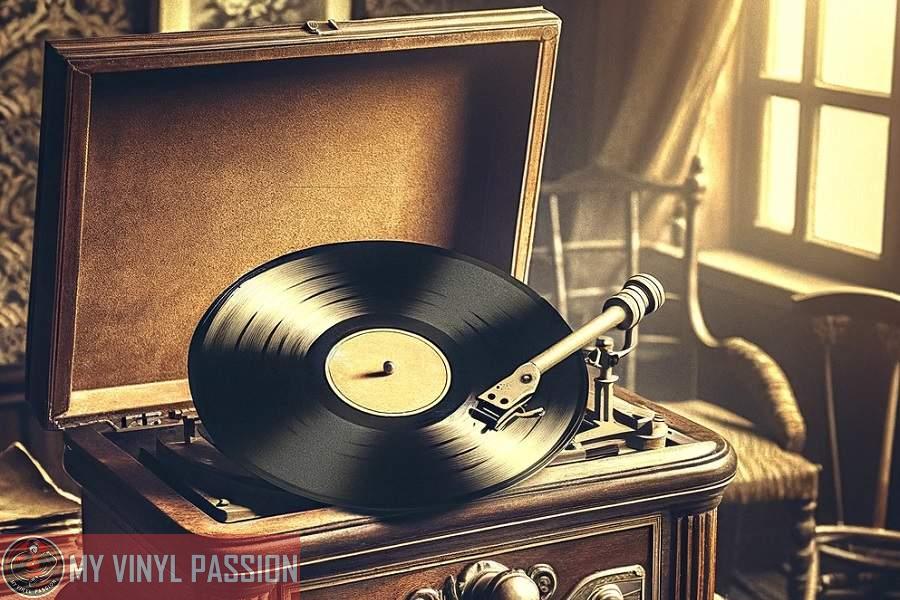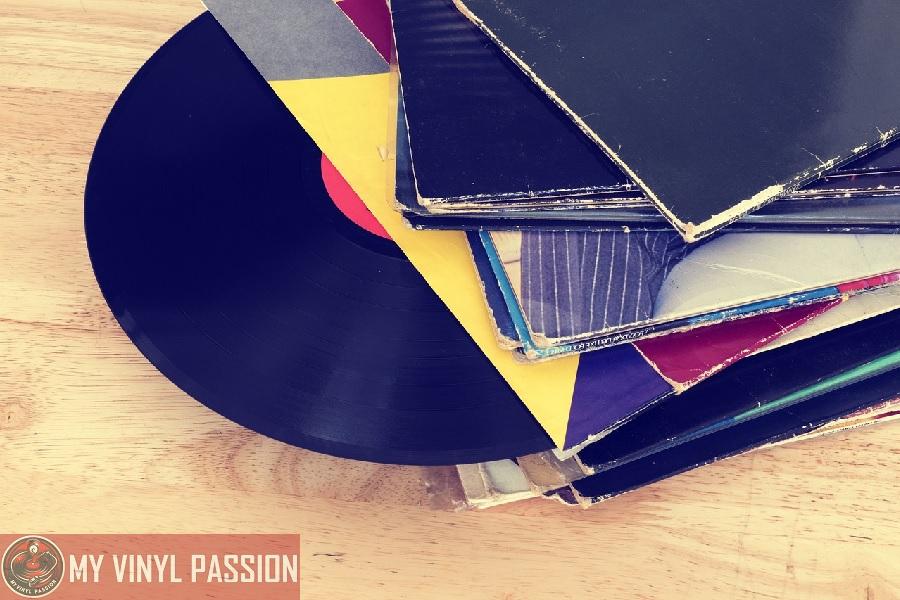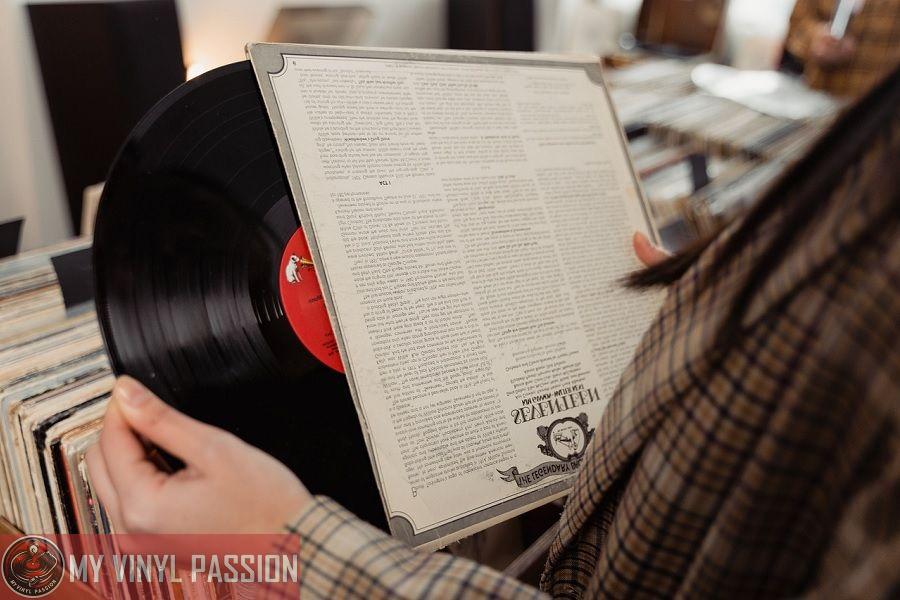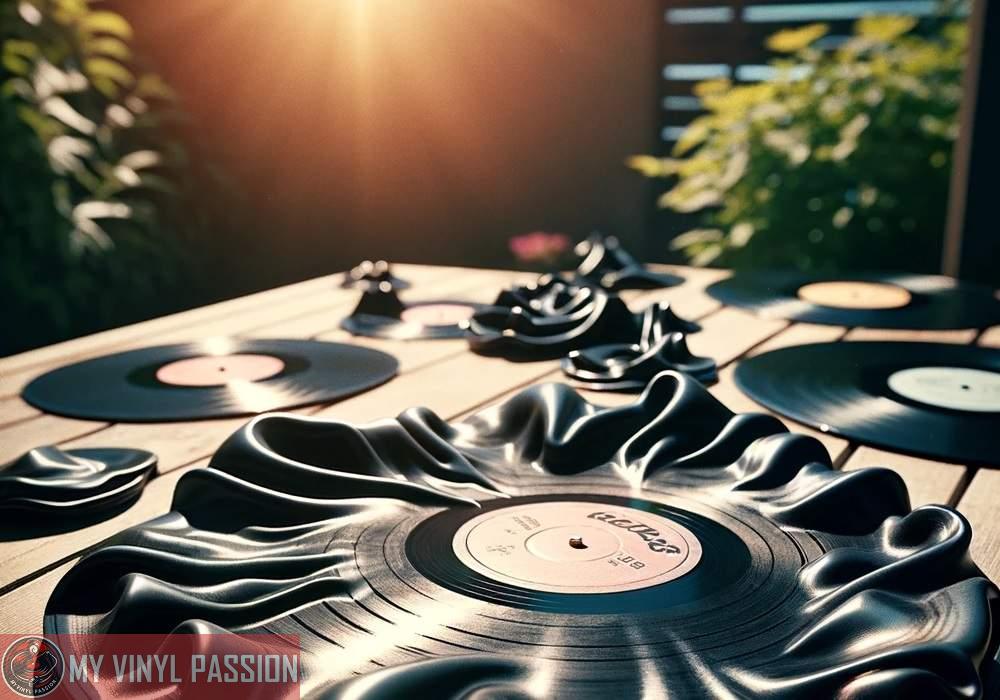The history of vinyl records is a fascinating journey through the evolution of sound recording technology.
One of the most significant moments in this history was when the first song was recorded on vinyl, forever changing how we experience and preserve music.
If you’re curious about which song holds this remarkable distinction, we’ve delved deeper into the matter to provide you with an answer.
In Summary
The first song recorded on vinyl dates back to the introduction of “Program Transcription” discs in 1930
Vinyl records revolutionized the sound recording industry with their increased durability and advanced technology
The introduction of vinyl allowed for longer playing times and improved sound quality, shaping today’s music listening and collecting experiences
In the early days of sound recording, various formats such as wax cylinders and shellac discs were used to capture audio. But, it wasn’t until the 1930s when vinyl records were introduced as a more advanced and durable alternative.
RCA Victor, a leading player in this space, launched the first commercially-available vinyl long-playing record, also known as “Program Transcription” discs, in 1930.
These 12-inch diameter flexible plastic discs were designed to spin at a speed of 33⅓ rpm, marking a significant leap in recording technology.
Origins of Sound Recording
Early Innovations
The journey towards recording sound began with the invention of the phonautograph by Édouard-Léon Scott de Martinville in 1857. This device could visually represent sound waves but did not have the capability to playback the recorded sound.
Although it was a groundbreaking innovation at the time, it was Thomas Edison’s invention of the phonograph in 1877 that marked a significant step in sound recording history.
As you delve deeper into the history of sound recording, the gramophone becomes an essential part of the story. Invented by Emile Berliner in 1887, this device utilized flat discs to record and reproduce sound, eventually becoming the staple method for the music industry.
Vinyl records eventually evolved from the gramophone, but the journey was still ongoing.
Development of Phonographs
The leap from phonographs to the first recorded songs on vinyl did not happen overnight. Initially, music was recorded on wax cylinders, such as in the Victor Talking Machine Company’s 1898 recording of “Twinkle, Twinkle, Little Star.”
This milestone paved the way for vinyl records to become a viable medium for recording and storing sound.
By the 1930s, vinyl records started being used by radio stations for playing songs by popular artists of the time. However, it wasn’t until the 1940s when vinyl records became publicly accessible, with the first LP (long-playing) record being released in 1948.
The development of sound recording technology has had an immense impact on the music industry. From the early innovations of the phonautograph and gramophone to the invention of the phonograph, each step has shaped the way people consume and appreciate music.
As you continue to explore the complex history of recorded music, remember to appreciate the pioneers who paved the way to make today’s incredible listening experiences possible.
Evolution of Recording Formats
From Wax to Shellac
In the late 19th and early 20th centuries, many recording methods were developed. You might be surprised to learn that one of the earlier methods involved using wax.
These were known as wax cylinders, and they served as the primary format for audio recordings for some time. Yet, as you might imagine, wax cylinders were fragile and prone to damage.
As recording technology progressed, the industry eventually shifted towards using shellac records. Introduced in the early 1900s, these 78 RPM records were made from a brittle material that was much sturdier than wax.
While they offered better durability and audio quality, they still had their limitations, such as a short playback time and susceptibility to scratches.
Invention of Vinyl
The invention of vinyl records marked a significant turning point in the history of recorded music. In 1948, CBS introduced the first 12-inch, 33-RPM record made of polyvinyl chloride (PVC). The use of PVC as the recording material provided numerous advantages:
- Durability: Vinyl records were more resistant to scratches and damage compared to shellac records.
- Longer playback time: Thanks to the slower rotation speed and larger size, a 12-inch vinyl record could hold an album’s worth of songs on each side, compared to just a single song per side on a 78 RPM shellac record.
- Improved audio quality: The use of PVC resulted in a reduction of surface noise, providing listeners with a cleaner, more enjoyable sound.
The introduction of vinyl as a recording medium revolutionized the music industry, paving the way for our modern understanding of albums and record collections. Today, vinyl records continue to thrive as a beloved format, appreciated by audiophiles and casual listeners alike for their rich audio quality and tactile appeal.
The First Vinyl Recordings
Breakthrough by RCA Victor
In the early days of audio recordings, materials like glass and tinfoil preceded the invention of vinyl records. However, it was RCA Victor who revolutionized the industry by developing the long-playing record in 1930.
The company successfully used vinyl material to create durable and high-quality records, which could store more music in comparison to their predecessors.
In this era, 78-RPM records were the norm. This format, despite breaking easily and having limited playing time, dominated the market for years.
With RCA Victor’s invention, the stage was set for the introduction of newer formats, such as the 45 RPM and 33⅓ RPM, which would change the landscape of recorded music.
Commercial Release and Impact
The commercial release of the first vinyl record came almost two decades later, in 1948, when CBS produced the first 12-inch 33-RPM record. This format allowed for an album’s worth of songs on each side, making it incredibly appealing to the booming post-war entertainment industry.
The newly established format offered numerous advantages, such as:
- Longer playing time
- Better sound quality
- Increased durability compared to shellac records
As a result, vinyl records swiftly became the most popular and widely used music-playing and recording medium, overshadowing 78-RPM records. This also paved the way for the 45-RPM format, introduced by RCA Victor in 1948, which became highly sought after for its portability and compatibility with jukeboxes.
Here’s a quick comparison of the formats:
| Format | RPM | Playing Time | Size |
|---|---|---|---|
| Vinyl | 33⅓ | 20-30 minutes | 12 inches |
| Vinyl | 45 | 4-6 minutes | 7 inches |
| Shellac | 78 | 3-5 minutes | 10-12 inches |
The transition from 78-RPM records to vinyl records marked a significant milestone in the music industry, ushering in a new era of listening experience and creating a lasting impact on how music was consumed and appreciated.
Advancements in Record Players
Improving Sound Fidelity
Over the years, various improvements have been made to enhance the sound quality of vinyl records.
Early record players were quite crude and didn’t have the fidelity we enjoy today. The invention of the electrically-powered turntable motors in the early 1900s allowed for a more consistent playback speed, which was set at 78 rpm.
The needle and cartridge also underwent advancements through time. Initially, steel needles were used, which were later replaced by sapphire and diamond ones. These new materials offered better sound clarity and durability.
In terms of the cartridge, magnetic cartridges eventually replaced the earlier crystal ones. This contributed significantly to improved sound fidelity.
From Mono to Stereo
The early record players were mono systems, meaning the audio was recorded and played back on a single channel. As you can imagine, this limited the listening experience. Things changed, however, with the introduction of stereo recording in the 1950s.
This advancement provided more realistic sound by utilizing two separate audio channels.
In a stereo setup, each channel has a separate turntable, needle, and cartridge that reproduce the audio from the left and right speakers. This results in a more dynamic, immersive sound experience. You can appreciate the music with more depth, as if you were part of the band or orchestra.
Let’s recap the key advancements:
- Turntable motors allowing for consistent playback speed
- Sapphire and diamond needles replacing steel ones
- Magnetic cartridges improving sound fidelity
- The shift from mono to stereo audio
Embrace these advancements that have shaped the way we enjoy vinyl records today, and continue exploring the fascinating world of record players. Remember, your listening experience is shaped by these developments, and ultimately, by your preferences and passion for music.
Vinyl Records in the Music Industry
Rise of Popularity
In the early days of the music industry, vinyl records became the primary format for distributing and listening to music.
The first 12-inch LP (long-playing) record was introduced by Columbia Record Company in 1948, followed by RCA Victor’s introduction of the 7-inch 45 rpm (revolutions per minute) record in 1949. These new formats enabled fans to listen to whole albums or collect singles from their favorite artists.
As vinyl records gained popularity, they eventually replaced shellac records in the 1950s and 1960s. During this time, the music industry flourished with vinyl as its primary medium, and artists released a plethora of popular albums.
However, by the late 1970s and 1980s, new formats emerged, namely cassette tapes and compact discs (CDs). These new formats, along with a growing interest in digital music, led to a decline in vinyl’s popularity.
Market Competition from Other Formats
Cassette tapes, invented by Phillips in 1962, boasted a more compact design and portability, allowing listeners to enjoy their music on the go. This new format gained immense traction and even outsold vinyl records for a brief period in the late 1980s.
But the music industry didn’t stop there. In the 1980s, the compact disc (CD) was introduced as another alternative to vinyl. CDs provided higher audio quality and a longer playback duration, which contributed to vinyl’s waning popularity.
As the century turned, another format entered the market: MP3. With the advent of the internet and digital technology, consumers found it easier to access and store their music digitally. This development further contributed to the decline of vinyl, as well as cassette tapes and CDs.
Despite these challenges, vinyl records experienced a resurgence in the 21st century, with a growing number of people seeking to recapture the nostalgia and warmth of analog sound.
As you explore the rich history of vinyl records, appreciate their impact on the music industry and the enduring love for this classic medium.
Cultural Impact and Collectibility
Iconic Releases and Artists
Vinyl records have been a significant part of music culture for over a century, with many iconic releases and artists contributing to their enduring popularity.
One of the most famous bands in history, The Beatles, helped shape the music industry during their time and remain popular amongst vinyl collectors to this day. Their albums, like “Revolver” or “Sgt. Pepper’s Lonely Hearts Club Band,” represent the high-quality music and innovative production techniques that defined the vinyl era.
Other popular artists, such as Pink Floyd, Led Zeppelin, and David Bowie, also made a strong impression on the cultural fabric of society.
The vinyl format allowed these artists to create unique, immersive experiences that listeners could not only hear but also participate in through album artwork, liner notes, and gatefold packaging.
Collectors and Vinyl Revival
The enduring appeal of vinyl records extends beyond the iconic artists who released their music on vinyl.
Collectors have played a prominent role in maintaining the cultural significance of records, with many developing a deep appreciation for the physicality and sound quality that only vinyl can provide. The growing vinyl revival has led to a resurgence in interest among both casual listeners and dedicated collectors alike.
Events like Record Store Day have been instrumental in fueling this renaissance, providing an opportunity for people to support local independent record shops while adding limited edition releases to their collections.
These annual celebrations have also helped to introduce new audiences to vinyl records, broadening the appeal of the format to younger generations.
Here are some key aspects of vinyl records that make them so appealing to collectors:
- Sound quality: The analog nature of vinyl provides a unique listening experience that many claim is warmer and more immersive than digital formats.
- Physicality: Collecting and handling vinyl records gives enthusiast a tangible connection to the music.
- Artwork: The larger format of vinyl records allows for more substantial and detailed cover art, adding to the overall experience.
As you continue to explore the world of vinyl records, it’s vital to appreciate the cultural impact that these iconic releases, artists, and collectors have had on society.
By embracing their unique appeal and supporting the ongoing vinyl revival, you’re contributing to a rich and enduring musical legacy.
Modern Vinyl Manufacturing
Materials and Processes
The primary material used in modern vinyl records is polyvinyl chloride (PVC), which is why we often refer to them as “vinyl.” Records today come in various sizes, including the 12-inch LPs and 7-inch singles. When creating a vinyl record, the audio is etched into the PVC in the form of grooves.
To start the process, a master recording is created, which is used to make a metal stamper. The stamper is placed into a hydraulic press along with a puck of PVC.
This press will apply heat and pressure, causing the puck to take on the shape of the grooves on the stamper. Once pressed, the record is then trimmed to the appropriate size, usually a 12-inch or 7-inch diameter.
- Speeds
- 33 1/3 RPM: Long-playing (LP) records, typically with a 12-inch diameter
- 45 RPM: Singles or extended play records, usually 7-inch diameter
During the manufacturing process, it is essential to ensure the vinyl’s quality. Some common issues that can surface include warping, scratches, or uneven weight distribution.
Quality and Durability
One primary aspect of the quality of a vinyl record is its durability. The PVC construction helps in making the record sturdier and more resistant to damage.
However, records can still be prone to warping if they are exposed to high temperatures, humidity, or direct sunlight over extended periods. Consequently, it is essential to store your vinyl collection in a cool, dry place away from direct sunlight.
Scratches can also affect the sound quality, so ensure you handle your records with care. When removing a record from the jacket, hold it by the edges and avoid touching the grooves.
The thickness and weight of a vinyl record can factor into its durability and overall sound quality. Thicker records are generally considered more durable and provide a richer sound due to deeper grooves. The most common record weights are:
- Standard: 120-140 grams
- Heavyweight: 180 grams or more
In summary, modern vinyl manufacturing uses PVC material and precise processes to create quality records. To maintain the durability and sound quality of your vinyl collection, ensure proper storage and handling. With a bit of care, you can enjoy your favorite tunes on vinyl for years to come.
Vinyl in the Digital Age
Nostalgia and Audiophile Appeal
In recent years, there has been a resurgence of interest in vinyl records, driven partly by nostalgia and the appeal of a physical medium.
Many music enthusiasts, particularly millennials, have been drawn to the larger album artwork, the tactile nature of handling a record, and the process of placing it on a turntable.
Another significant factor in this revival is the audiophile argument that vinyl offers superior audio quality. Many audiophiles claim that vinyl has a warmer and more genuine sound compared to digital formats like CDs or MP3s.
Additionally, they argue that the analog nature of vinyl leads to a higher audio fidelity, capturing the nuances of a recording that may be lost in digital compression.
Integration with Digital Systems
As vinyl records have gained popularity, there has been an effort to integrate them with modern digital systems. This has led to a range of devices and software designed to help you enjoy your vinyl collection while still taking advantage of the convenience of digital media.
For example:
- USB Turntables: These turntables allow you to connect directly to your computer. This enables you to digitize your vinyl records into MP3s, preserving your collection while making it more accessible.
- Bluetooth Turntables: Modern turntables often come with built-in Bluetooth capabilities. This allows you to wirelessly stream music from your vinyl records to your Bluetooth-enabled speakers or headphones.
- Mobile Applications: There are several mobile apps available that help you manage your vinyl record collection. These apps allow you to catalog your records, retrieve album information, and even find the best local shops for purchasing vinyl records.
By bridging the gap between analog and digital, these innovative solutions help ensure that vinyl records remain relevant and accessible in the digital age.
Frequently Asked Questions
What song holds the distinction of being the first with lyrics to be captured on a recording?
“À Claire Fontaine,” a French folk song, is considered the first recorded song with lyrics. Édouard-Léon Scott de Martinville recorded it on his invention, the phonautograph, in 1860. The recording, though primitive, marked a significant milestone in the history of recorded music.
How did the history of recorded music begin?
The history of recorded music began with the invention of the phonautograph by Édouard-Léon Scott de Martinville in 1857. It was capable of visually recording sound waves on paper. This paved the way for Thomas Edison’s invention of the phonograph in 1877, which used tinfoil cylinders to record and reproduce sound.
Which song was the inaugural track recorded on the phonograph?
The first song to be recorded on Thomas Edison’s phonograph was “Mary Had a Little Lamb.” Edison recited this nursery rhyme in 1877, and the phonograph successfully played back the recording, marking a significant breakthrough in audio technology.
What are the key differences between an LP record and vinyl?
An LP (Long Play) record is a type of vinyl record that spins at a speed of 33 1/3 RPM and can contain multiple tracks on each side. Vinyl is the material used to make LP records, as well as other recording formats such as 45s and 78s. The term “vinyl” has become synonymous with records, but it technically refers to the material rather than the format.
Can you identify the year the first vinyl record was produced?
The first vinyl record was produced in 1930 by RCA Victor. It was a 12″ diameter flexible plastic disc marketed as “Program Transcription” discs, designed for playback at 33 1/3 RPM. Vinyl records would later become publicly accessible in the 1940s.
What defines the first pressing in the context of vinyl records?
In the context of vinyl records, a first pressing refers to the initial batch of records pressed from the original set of master plates used to create a particular album. Collectors often seek out first pressings because they believe these versions are the closest to the artist’s original intent and, therefore, the best in terms of sound quality.





